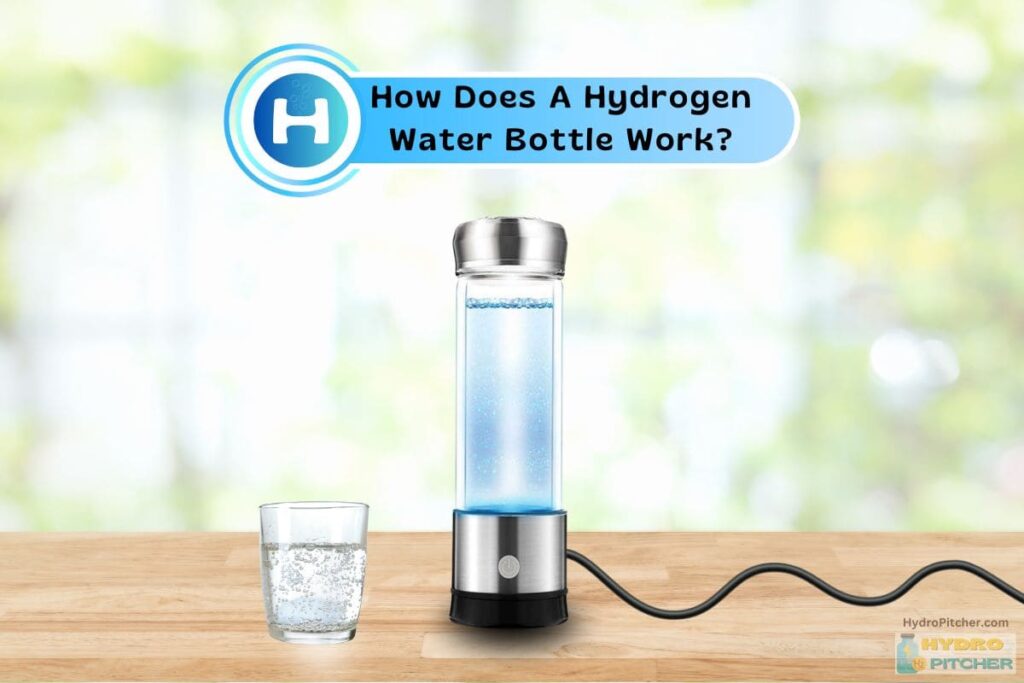Howdy fellow fitness freaks! I’ve been exploring hydrogen water bottles to see what they’re all about. These bottles are gaining popularity for their potential health benefits, but how do they actually work?
After trying out several models and doing some research, I’ve got the answers. In this article, I’ll explain how hydrogen water generators infuse regular water with hydrogen gas, breaking down the key components and the process involved.
Whether you’re into fitness like me or just curious about new health trends, understanding how these bottles function can help you decide if they’re worth a try. Let’s get into it!

Parts Of A Hydrogen Water Bottle And Their Functions
From the outside, hydrogen water bottles are lightweight and look like cylindrical bottles that come with a fitted lid and a specialized bottom. This bottom part is where it contains the main functional components, i.e., the generator module, which I will tell you about in a short while.
A. Borosilicate Or Tritan Glass Body
The outer casing of the hydrogen water bottles is mostly made up of BOROSILICATE glass. This particular material is widely popular for being durable, environment-friendly, as well as food-safe. Apart from the fact that it is BPA-free, this material also makes the surface resistant to fluctuating temperatures.
I have also come across hydrogen water generators made up of TRITAN, which is also extensively used to manufacture long-lasting and food-grade bottles and kitchen appliances. For me, it does not matter if my bottle is made of borosilicate or a Tritan because both are equally robust and safe for long-term use.
B. Generator Module
Below the glass body, towards the bottom of the bottle, lies the compact generator module that contains the main ELECTROLYZER CELL. That is, this module houses the main technological components that produce hydrogen-rich water. The generator employs SPE and PEM technologies, based on the fundamental principles of electrolysis and hydrogen infusion, to produce molecular H2 from water.
SPE or Solid Polymer Electrolyte technology is employed in the process of electrolysis, which splits regular water into hydrogen and oxygen.
On the other hand, the PEM or Polymer Electrolyte Membrane technology works in tandem with SPE, helping extract the hydrogen ions (positively charged particles) after electrolysis. It allows only the positively charged H+ ions to pass through it while blocking out others like chlorine, oxygen, and ozone, the byproducts of electrolysis.
So, PEM technology ensures that only pure hydrogen gas is infused into the water.
The generator module of all hydrogen water bottles contains the following three core layers of the electrolyzer cell. This is where the SPE and PEM technologies play their parts – we shall explore them in a short while.
- Layer 1 (SPE technology) Platinum-Coated Cathode: Titanium, coated with pure platinum, is the most preferred material for the cathode in the SPE electrolysis cell. The cathode is the negative electrode, where the hydrogen gas generation takes place during electrolysis.
- Layer 2 (PEM technology) Polymer Electrolyte Membrane: The polymer electrolyte (PEM) membrane is the patented electrolytic filter that constitutes the middle layer in an SPE/PEM cell. It is sandwiched by the SPE cathode layer on one side and the SPE anode layer on the other. This membrane is essentially a solid polymer electrolyte that conducts protons, segregates gases formed as byproducts, and electrically insulates the cathode and anode.
- Layer 3 (SPE technology) Platinum-coated anode: Titanium, coated with pure platinum, is the most preferred material for the anode in the SPE electrolysis cell. This is the positive electrode, which produces oxygen, electrons, and protons due to electrolysis.
C. Release Valve
Right under the SPE/PEM electrolyzer cell lies the small chamber that drains out the gases generated as byproducts during the electrolysis of water. It contains a valve that helps release ozone (O3) gas, which is formed as a byproduct, along with other toxic gases like chlorine (Cl2) and hydrogen peroxide (H2O2).
D. Battery And Power Indicators
The power ON/OFF switch is accompanied by an LED light to signify when the bottle is being used and to process water to generate hydrogen-infused water actively.
Besides, every hydrogen water bottle kit comes with a standard USB power cable and plug. You need to recharge your bottle from time to time using the charging cable and plug provided in the packaging. The charging LED light, when ON, indicates that the bottle is being recharged and goes OFF once it is fully charged.

How Do These Components Work Together To Produce Hydrogen Water?
My experience using hydrogen water bottles has been favorable indeed because they are very convenient; I always have my supply of H2-rich water even when I am on the go.
I make sure that my hydrogen water bottle is always fully charged, and then whenever needed, I only fill it up with tap water and press the power ON button to start the process. After about 3 to 10 minutes, my bottle is READY with freshly prepared, ready-to-drink hydrogen-infused water.
But this is just the tip of the iceberg, for you will be intrigued to know about all that goes on in that tiny compact module within the bottle. Going through research papers and testing them myself, I have understood that the entire process of generating hydrogen-rich water takes place in two major phases – ELECTROLYSIS and INFUSION.
1. Electrolysis
- As soon as the hydrogen water bottle is filled with tap water and the power button is switched ON, the electric current splits water into hydrogen and oxygen atoms.
- The water reaches the SPE anode (layer 3 of the generator module) and dissociates into oxygen, electrons, and protons under the influence of electricity. These protons are positive ions of hydrogen (H+).
- The protons (H+ ions) and electrons are immediately attracted by the SPE cathode (layer 1 of the generator module).
- They pass through the PEM membrane (the sandwiched layer 2 of the generator module) to reach the cathode layer. There, the H+ ions combine with the electrons to form molecular hydrogen.
- It is then released into the water, and infusion instantly begins.
2. Infusion
- After the H2 molecules are released into the water contained in the bottle, they dissolve to produce hydrogen-rich water ready for consumption. Some generators can produce almost 99.9% pure hydrogen concentrate infused with water.
- The oxygen formed at the anode layer is released into the environment through a valve.
- In case gaseous byproducts such as chlorine and ozone are also formed during electrolysis, they are also expelled through the valve into a small chamber at the bottom of the generator module.
Learn More: How To Make Hydrogen Water At Home?
But Does It Purify The Water?
No. Hydrogen water bottles do not filter the water. Although it clears out the ozone and chlorine, it doesn’t work exactly like a RO water purifier. So, I had to use filtered or tap water as per the recommendation of their manufacturers.
However, you will also find that some brands of hydrogen water generators are equipped with reverse osmosis (RO) technology to ensure that only filtered, safe, and pure hydrogen-rich water is produced. But those appliances are large and not usually suitable for domestic use unless you have a really big family. The bottles and pitchers work just fine for most.
I have also come across hydrogen water bottles that feature FLUORIDE FILTRATION using an activated alumina medium. Fluorides can be the toughest to remove from water, but advanced filtration mechanisms using activated alumina help ensure that at least 70% of fluoride is eliminated throughout the filter life.
By Any Chance, Do Hydrogen Water Generators Add Chlorine To The Water?
Electrolysis of water DOES NOT introduce chlorine into the fluid. However, we need to remember that tap water might often contain impurities in the form of dissolved chloride salts. So when electricity passes through tap water, these chloride compounds tend to dissociate into their constituent chemicals, producing free chlorine as a byproduct.
While chlorine in trace amounts can be an effective disinfectant, it can alter the taste of drinking water, making it disagreeable for consumption.
If you remember, I mentioned a while ago that under the generator module in the hydrogen water bottle, is a release valve that helps expel chlorine and ozone into a tiny chamber. As a result, the hydrogen water remains free from chlorine, tastes just like regular water, and is absolutely okay for drinking.
However, like any appliances, hydrogen water bottles need periodic cleaning, and here is an article detailing the maintenance process.
Key Takeaways
Hydrogen water bottles are designed to contain an in-built generator module that facilitates the electrolysis of water to produce hydrogen-rich water.
These generators employ SPE and PEM technologies that work in tandem to carry out electrolysis and simultaneous infusion of molecular hydrogen into water.
The hydrogen water produced also remains free from chlorine, fluorides, chloramines, heavy metals, and other toxins.

